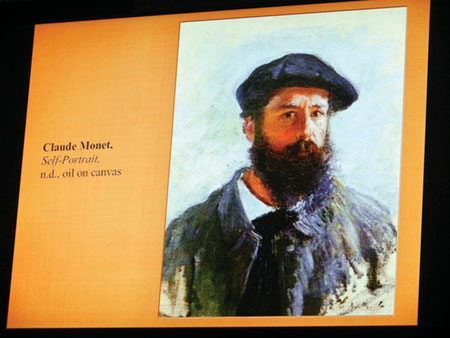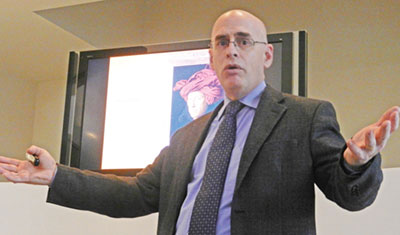
For the last two months, Preston Metcalf, chief curator at the Triton Museum of Art, has been taking art lovers on a journey – a journey At the Edge of Art History. On March 21, Metcalf continued the voyage with “Capturing the Inner-Image: Self Portraiture in the Hands of Masters.”
Historically, self-portraits were done for a few reasons – as a study of the time in which the artist lived, or to save money on a model, show the artist at work, show the world they’ve made it, share their feelings and thoughts, or make themselves part of the scene (hint: when viewing late medieval renaissance or baroque art, the person in the painting looking back at the viewer is the artist).
“When I look at [Claude] Monet, I know that this [self-portrait] was just a study and it was done because it was probably raining and he didn’t want to go outside,” said Metcalf. “And, he didn’t have money for a model but he had to paint – so he painted himself…I look at this now I say, ‘what do I know about Monet?’ I know what it’s like to be inside on a rainy day. I know what it’s like not to have any money. I know what it’s like to feel like I’m alone and maybe the world is passing me by…What does that tell me? I know him. I’ve just touched Monet. For a moment there we connected through distance, through multiple planes, through time…That’s what these are so valuable – because they connect us with people.”
The expression on an artist’s face, scene in which they paint themselves, and little details from clothing choice to accessories, tell the viewer something about the artist. In fact, self-portraits aren’t simply images of artists, they’re reflections of the viewer, and when a connection is made, the real art is revealed.

“If you are not experiencing [a connection to the artist] in your art viewing, you’re missing something,” said Metcalf. “You need to slow down. You need to ask the question: ‘What is this telling me?’ Don’t be afraid to read into it…Your goal in viewing any art, especially portraiture should be to find that little road that opens up, that makes you touch the artist. If you don’t find that, if you don’t experience that, you haven’t gone far enough.”
Self-portraits aren’t always what traditionally comes to mind either – Vincent van Gogh’s work boots, and the bull in Pablo Picasso’s Guernica are examples of the artist infusing themselves in a non-traditional way into the painting. These, too, are self-portraits.
“What can we learn from all of these self-portraits?” said Metcalf. “For all of you who are artists, go rethink what you are painting. Have you bared yourself enough?”
At the Edge of Art History continues Thursday, April 18 at 7 p.m. with “Europe Under Fire,” a lecture about the Adolph Hitler-Herman Goering initiated art heist. Drop in fee is $20. Visit http://tritonmuseum.org/education_adults_arthistory.php for more information.





